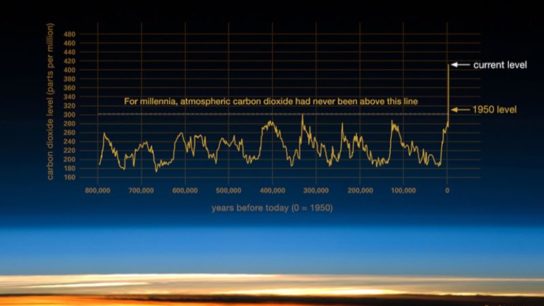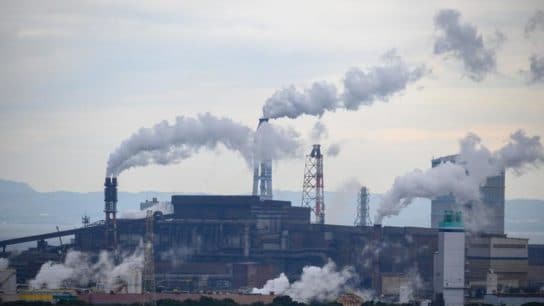The average wildfire season in Western US is now 105 days longer, burns six times as many acres, and sees three times as many large fires, according to Climate Central. Earth.Org looks at the data to establish whether there is a link between increased wildfire activity and drought severity.
—
Drought is one of the most devastating natural disasters, affecting millions of people worldwide. Unlike hurricanes or earthquakes, droughts develop slowly and can persist for months, years, and even decades, leading to lasting effects on agriculture, water supply, and ecosystems.
In 2024, 48 of 50 US states faced drought conditions, the highest proportion ever recorded in the country, while wildfires scorched over 8.9 million acres nationwide. As climate change accelerates, droughts are becoming more frequent and widespread, and their relationship with wildfires is no longer speculation.
Drought Trends
Drought occurs when a region experiences prolonged periods of lower-than-average precipitation, leading to water shortages and drier lands. Both natural and human factors can influence it, including varying climatic conditions, rising global temperatures, deforestation, and unsustainable water use.
The US Drought Monitor provides historical drought data, classifying drought severity into categories ranging from D0 (Abnormally Dry) to D4 (Exceptional Drought).

A time series plot from 2000 to January 2025 illustrates trends across different drought categories (D0 to D4), revealing a periodic pattern. Severe droughts (D2-D4) peak every 3-5 years, likely influenced by climate oscillations such as El Niño and La Niña. Autocorrelation tests confirm this periodicity, showing strong correlations at 2-3 year lags, particularly for D3–D4 droughts.
Additionally, drought severity has intensified, with “exceptional drought” coverage increasing by 12% since 2000. While mild droughts (D0–D1) follow annual wet/dry cycles, severe droughts (D2–D4) persist for multiple years.
Given this cyclical behavior, an important question arises: do wildfires follow a similar pattern?

Wildfire Trends
Using historical wildfire data from the National Interagency Fire Center, we analyzed the total acres burned over the years. The data reveals that wildfires also exhibit a periodic pattern. This raises a critical question: is there a direct relationship between drought and wildfires?
To investigate this, we utilized a Normalized Weighted Drought Index, which quantifies drought severity on a scale from 0 (least severe) to 10 (most severe) by weighting different drought categories. Similarly, wildfire data including total acres burned and the number of fires was normalized to enable a direct comparison with drought severity.
Normalization is a method that scales different types of data to a common range, allowing us to compare them more fairly. For instance, drought severity may range from 0 to 10, while acres burned could be in the thousands or millions. Without normalization, one might appear more significant just because it uses larger numbers. By bringing everything to the same scale, we avoid misleading comparisons and can better evaluate how closely drought conditions and wildfire activity are connected. This approach provides a dimensionless framework to explore their correlation more accurately.

The plot reveals a strong relationship between drought severity and wildfire activity, with extreme drought years, such as 2020, coinciding with an increase by 2.5 times in burned area compared to non-drought years. However, an anomaly appears between 2011 and 2015, where overall drought levels were lower, yet wildfire activity remained high.
A more focused analysis considering only severe drought conditions (D3-D4) provides further clarity, highlighting that localized extreme droughts can significantly impact fire activity, even when total drought levels appear moderate. This suggests that while broader drought classifications may not always capture fire risk accurately, high-intensity droughts in fire-prone regions play a crucial role.

The data also shows that fire frequency increased by 40% in the western US during severe droughts. A case study from 2020, when D4 drought covered 23% of the western US, aligns with a record 10.1 million acres burned. Time series plots indicate overlapping spikes in drought severity (D3-D4) and wildfire acreage during key periods, such as 2011–2015 and 2017–2021. This trend is particularly evident in California, where persistent drought conditions from 2011 to 2017 closely align with intensified wildfire activity, as well as the record-breaking fires of 2020 and beyond.
From the data, it is evident that there is a strong correlation between drought severity and wildfire activity. As climate change accelerates, addressing this relationship through proactive policies and climate adaptation strategies becomes increasingly urgent. Policy urgency is evident, as regions with frequent D3–D4 droughts, particularly in California and the Southwest, require enhanced fire mitigation strategies and water-resilient infrastructure.
Featured image: CAL FIRE_Official/Flickr.
You might also like: 3 Facts About California’s Climate That Explain the LA Fires
—








![The Statistics of Biodiversity Loss [2020 WWF Report]](https://earth.org/wp-content/uploads/2020/12/lprwinkyTHB-544x306.jpg)






